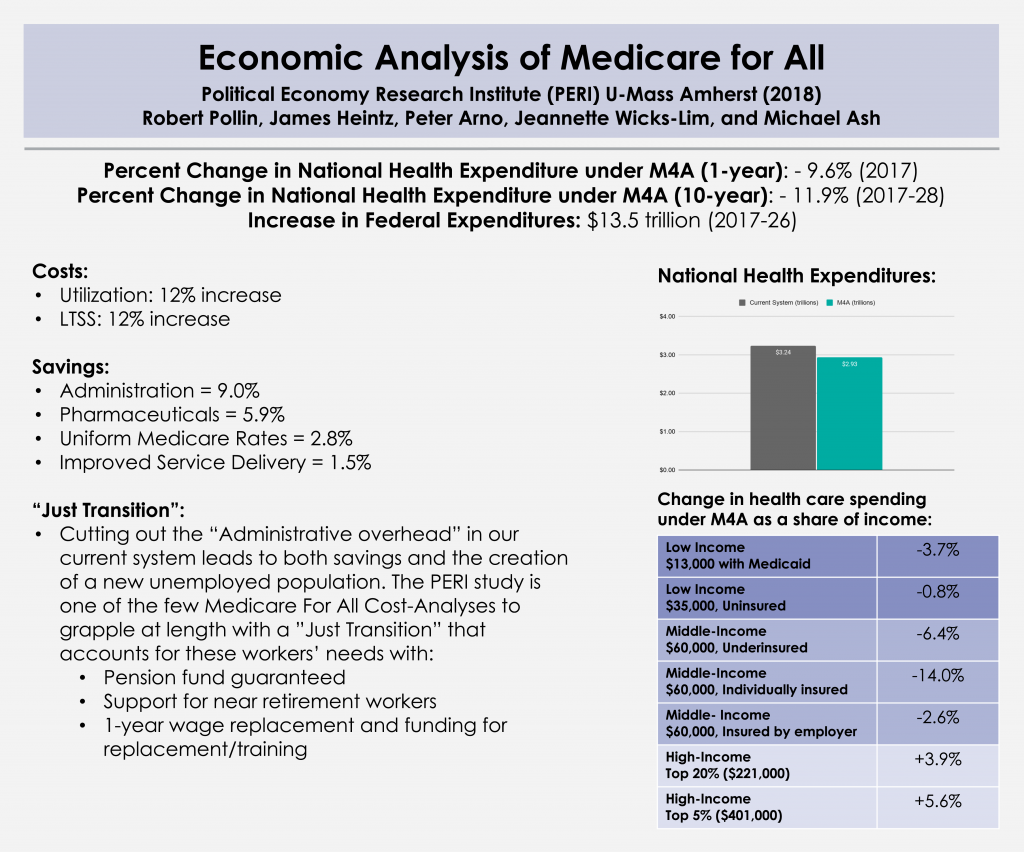Title: Economic Analysis of Medicare for All
Year: 2018
Author: Robert Pollin, James Heintz, Peter Arno, Jeannette Wicks-Lim, and Michael Ash
Institution: Political Economy Research Institute (PERI) U-Mass Amherst
Funding Source: California Nurses Association/National Nurses United
Plan Analyzed: S. 1804 Medicare for All Act of 2017
Percent Change in National Health Expenditure under M4A (1-year): -9.6% (2017)
Percent Change in National Health Expenditure under M4A (10-year): -11.9% (2017-26)
Increase in Federal health expenditures: $1.35 trillion (2017-26)
Read Study:
PERI – Economic Analysis of Medicare for All
Study Abstract:
This study by PERI researchers Robert Pollin, James Heintz, Peter Arno, Jeannette Wicks-Lim and Michael Ash presents a comprehensive analysis of the prospects for a Medicare-for-All health care system in the United States. The most fundamental goals of Medicare for All are to significantly improve health care outcomes for everyone living in the United States while also establishing effective cost controls throughout the health care system. These two purposes are both achievable. As of 2017, the U.S. was spending about $3.24 trillion on personal health care—about 17 percent of total U.S. GDP. Meanwhile, 9 percent of U.S. residents had no insurance and 26 percent were underinsured—they were unable to access needed care because of prohibitively high costs. Other high-income countries spend an average of about 40 percent less per person and produce better health outcomes. Medicare for All could reduce total health care spending in the U.S. by nearly 10 percent, to $2.93 trillion, while creating stable access to good care for all U.S. residents.
Overview:
- The PERI study is a lengthy and comprehensive cost-analysis study. The authors explain their assumptions and counterfactuals at length and show their calculations in a very easy-to-follow format.
- The Report contains 7 sections:
- Chapter 1: Underscores why affordable health care can improve health outcomes
- Chapters 2-3: Identifies sources of costs and savings
- Chapter 4: Financing Plans for Medicare For All
- Chapter 5: Effects of financing plans on families (based on income) and businesses (small, medium, and large)
- Chapter 6: Considers the logistics and the costs of transitioning from our current system to a single-payer system (“Just Transition”)
- Chapter 7: Estimates the effects of Medicare for All on health care spending as a share of US GDP, and other macroeconomic impacts
PNHP Response:
PNHP co-founders Drs. Steffie Woolhandler and David Himmelstein, and PNHP president Dr. Adam Gaffney, submitted a reviewer assessment of the PERI study. They note that the PERI analysis may understate administrative savings, but overall find it to be a “highly credible economic analysis.”
Further Reading:
Facing job loss with Just Transition (KHN)
